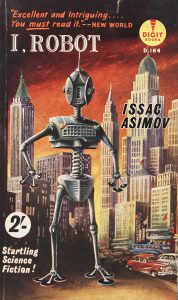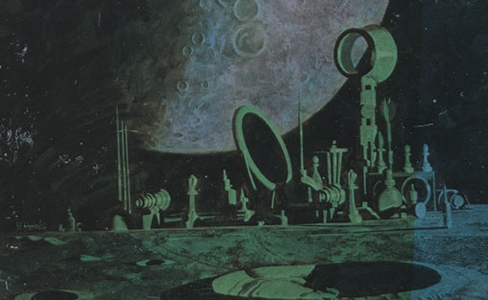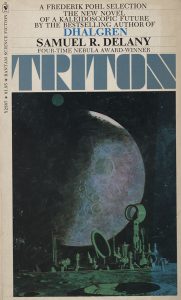And this disease was called The Loneliness, because when you saw your home town dwindle the size of your fist and then lemon-size and then pin-size and then vanish in the fire-wake, you felt you had never been born, there was no town, you were nowhere, with space all around, nothing familiar, only other strange men.
(From: Ray Bradbury, The Martian chronicles, 1950)
 Part 1 of this post took a look at Ballantine Books in the Mottram collection, and how Ballantine championed the rise of the speculative fiction paperback in the 1950s. Professor Eric Mottram’s Ballantines included others in addition to Bradbury and Lovecraft, however: we hold Synthetic men of Mars, Edgar Rice Burroughs’s ninth Barsoom book (Bob Abbett’s typically colourful cover illustration depicts a lot of shirtless sword fighting), and the only published edition of The seed by Dan Thomas. The seed was one of only three science-fiction novels by Dan Thomas, a pseudonym of Leonard Sanders, who otherwise wrote thrillers and Texan historical fiction. Added to these, excitingly (and appropriately), is a rare 1968 printing of Childhood’s end, the iconic classic penned by King’s College London alumnus Arthur C Clarke – the Ballantine paperback is the eighth printing of the novel’s first edition, published in 1953.
Part 1 of this post took a look at Ballantine Books in the Mottram collection, and how Ballantine championed the rise of the speculative fiction paperback in the 1950s. Professor Eric Mottram’s Ballantines included others in addition to Bradbury and Lovecraft, however: we hold Synthetic men of Mars, Edgar Rice Burroughs’s ninth Barsoom book (Bob Abbett’s typically colourful cover illustration depicts a lot of shirtless sword fighting), and the only published edition of The seed by Dan Thomas. The seed was one of only three science-fiction novels by Dan Thomas, a pseudonym of Leonard Sanders, who otherwise wrote thrillers and Texan historical fiction. Added to these, excitingly (and appropriately), is a rare 1968 printing of Childhood’s end, the iconic classic penned by King’s College London alumnus Arthur C Clarke – the Ballantine paperback is the eighth printing of the novel’s first edition, published in 1953.
Ballantine were far from alone in the 1950s – ma ny other paperback imprints were also picking up on sci-fi. Brown, Watson Ltd in the UK had Digit Books, through which they published an array of spacefaring adventures and apocalyptic calamities. Held in the Mottram collection is a rare Digit Books edition of The space merchants, the still-relevant satire on 1950s advertising by Frederik Pohl and CM Kornbluth. Kornbluth sadly passed away at the age of just 34, five years after The space merchants saw publication; Pohl, before moving onto editorial positions for magazines, had acted as literary agent to Isaac Asimov in the late 1930s, and we hold a rare Digit Books edition of Asimov’s most famous work, too: I, robot. The front cover depicts a towering automaton just slightly different to those in the Will Smith movie, and Asimov’s first name is misspelt ‘Issac.’ Like Bradbury’s The Martian chronicles, this book is a ‘fixup’ novel, reworking earlier published short stories into a more seamless narrative – this edition of I, robot, however, excludes two of the stories from the collection’s original publication.
ny other paperback imprints were also picking up on sci-fi. Brown, Watson Ltd in the UK had Digit Books, through which they published an array of spacefaring adventures and apocalyptic calamities. Held in the Mottram collection is a rare Digit Books edition of The space merchants, the still-relevant satire on 1950s advertising by Frederik Pohl and CM Kornbluth. Kornbluth sadly passed away at the age of just 34, five years after The space merchants saw publication; Pohl, before moving onto editorial positions for magazines, had acted as literary agent to Isaac Asimov in the late 1930s, and we hold a rare Digit Books edition of Asimov’s most famous work, too: I, robot. The front cover depicts a towering automaton just slightly different to those in the Will Smith movie, and Asimov’s first name is misspelt ‘Issac.’ Like Bradbury’s The Martian chronicles, this book is a ‘fixup’ novel, reworking earlier published short stories into a more seamless narrative – this edition of I, robot, however, excludes two of the stories from the collection’s original publication.
The New American Library ventured into sci-fi in the 1950s, utilising their previously established paperback imprint, Signet Books. Both of our Signet Books are by Alfred Bester: a rare paperback of the very first Hugo Award winner, The demolished man, and a first edition of his 1958 short fiction collection, Starburst. The vivid, dramatic cover of The demolished man was painted by Stanley Meltzoff, who not only provided cover artwork for a number of other Signet science-fiction books, but who also painted for Life and National geographic.
Sci-fi innovator of the mid-20th century, Robert A Heinlein, is also represented with two paperbacks in the Mottram collection, both from other publishers: a Berkley Medallion edition of Stranger in a strange land from 1968, and a Four Square edition of Starship troopers from 1961. These are two of Heinlein’s most prominent works, with Starship troopers popularising the idea of the ‘space marine,’ to which concept modern science-fiction cinema and videogames owe a massive debt.
 Of all the authors featured in Mottram’s sci-fi, however, it is Samuel R Delany who is most present, with nearly 20 books. Whereas some of the science-fiction and horror mentioned thus far may have made it into Mottram’s library through various means, Delany is the writer that Mottram most perceptibly sought out – particularly as at least one of the books, Starboard wine, is a signed first edition.
Of all the authors featured in Mottram’s sci-fi, however, it is Samuel R Delany who is most present, with nearly 20 books. Whereas some of the science-fiction and horror mentioned thus far may have made it into Mottram’s library through various means, Delany is the writer that Mottram most perceptibly sought out – particularly as at least one of the books, Starboard wine, is a signed first edition.
Delany remains an important figure within the world of fantasy and science-fiction; it is not hard to see why, and it is not hard to see why he was a writer of great interest to Mottram: Delany was one of the first major African-American authors of speculative fiction, and also one of the first openly gay authors of it; his first novel was published in 1962 when he was just 20 years old, and he has since accumulated numerous awards for his writing. Of particular interest to Mottram was Delany’s subversion of tropes: in his essay ‘American fiction in the sixties,’ Mottram wrote that Delany used his 1967 novel The Einstein intersection to ‘[exorcise] … the petty gangster cowboy, Billy the Kid, as an American folk hero,’ going on to say that, ‘Delany knows that myths of destruction are man-made, not simply “natural” or part of necessity, and that their analysis and elimination is a necessity.’1
 The ‘first novel’ referenced above, The jewels of Aptor, is a combination of science-fiction and fantasy, and the Mottram collection contains a 1971 Sphere Books edition. This edition contains the full, restored text – unlike William S Burroughs’s Junkie, edited by Ace Books in the 50s to remove and/or dilute overt references to homosexuality and drug-taking, the first edition of The jewels of Aptor was only trimmed to make room for its Ace-Double, Second ending by James White. Had they still been his publisher into the 1970s, Ace would most definitely have found question with Delany’s more ‘explicit’ novels.
The ‘first novel’ referenced above, The jewels of Aptor, is a combination of science-fiction and fantasy, and the Mottram collection contains a 1971 Sphere Books edition. This edition contains the full, restored text – unlike William S Burroughs’s Junkie, edited by Ace Books in the 50s to remove and/or dilute overt references to homosexuality and drug-taking, the first edition of The jewels of Aptor was only trimmed to make room for its Ace-Double, Second ending by James White. Had they still been his publisher into the 1970s, Ace would most definitely have found question with Delany’s more ‘explicit’ novels.
Ace Books went on publishing Delany’s works (mostly as Ace-Doubles) throughout the 1960s, and Sphere Books continued to publish them in the United Kingdom later on – we hold Sphere copies of Out of the dead city, The towers of Toron, City of a thousand suns and The Einstein intersection, as well as Nova, which was first published by Doubleday. Completing Delany’s run at Ace, we also hold an Ace Book that compiles The ballad of Beta-2 and Empire star together. It is uniquely satisfying, in such an eclectic collection, to hold a complete run of something!
 In the 1970s, Delany published four novels, including some of his major works; we hold first editions of both Dhalgren and Triton – their celestial cover illustrations were painted by Mitchell Hooks, who provided art for a great many books and magazines, and who also designed the poster for Dr. No (look closely at the cover for Triton and you’ll see that the grand structures are actually household objects!2). From 1979 and into the late 1980s, Delany worked on a series of sword and sorcery stories, set in the land of Nevèrÿon. We hold the Bantam-published first editions of the first two Nevèrÿon publications: Tales of Nevèrÿon, and Neveryóna. The cover illustrations for these are painted by Rowena A Morrill, one of a small number of women artists providing art for paperbacks at the time.
In the 1970s, Delany published four novels, including some of his major works; we hold first editions of both Dhalgren and Triton – their celestial cover illustrations were painted by Mitchell Hooks, who provided art for a great many books and magazines, and who also designed the poster for Dr. No (look closely at the cover for Triton and you’ll see that the grand structures are actually household objects!2). From 1979 and into the late 1980s, Delany worked on a series of sword and sorcery stories, set in the land of Nevèrÿon. We hold the Bantam-published first editions of the first two Nevèrÿon publications: Tales of Nevèrÿon, and Neveryóna. The cover illustrations for these are painted by Rowena A Morrill, one of a small number of women artists providing art for paperbacks at the time.
It is certainly an assorted mix of science-fiction and horror that Professor Eric Mottram collected – while the speculative fiction only makes up a small portion of the wider wealth of his other literature, plenty of the genres’ big names and titles are represented, and we have interesting copies of a mingled range of books. Nearly all of these are paperbacks. While many of the publishers and imprints mentioned here have since been absorbed by the larger publishing houses, their impact for speculative fiction at the time was unmistakable: Ballantine Books, Ray Bradbury’s early supporter, went on in the 1960s to publish a popular edition of The lord of the rings, and shortly after the company’s purchase by Random House, it published Star wars: from the adventures of Luke Skywalker, a novelisation of Star wars that made it to the public in November 1976 – six months before the film.
All of the items mentioned, and many more, are currently being catalogued and formally added to our Special Collections holdings; we are happy to answer any enquiries pertaining to them (including arranging viewing) at: specialcollections@kcl.ac.uk.
Footnotes
1 Eric Mottram, ‘American fiction in the sixties,’ Mottram collection, King’s College Archives, MOTTRAM: 9/19/22-28
2 RC, ‘Look here: seven covers for seven novels by Samuel R. Delany,’ Ragged Claws Network, [https://raggedclaws.com/2013/06/10/look-here-seven-covers-for-seven-novels-by-samuel-r-delany/, accessed September 19, 2018]
The cover illustrations for Synthetic men of Mars, Starburst, and Triton shown here are reproduced courtesy of Penguin Random House.
We have undertaken reasonable endeavours to trace the copyright owners of the cover illustration for I, robot; if you are the rights holder and are concerned that permission was not granted for this image, please see the King’s College London Libraries and Collections Takedown Policy here.